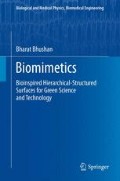Abstract
Unlike the Lotus leaf, some rose petals (rosea Rehd), scallions, and garlic exhibit superhydrophobicity with high contact angle hysteresis (Feng et al., 2008; Chang et al., 2009; Bhushan and Her, 2010). While a water droplet can easily roll off the surface of a Lotus leaf, it stays pinned to the surface of these leaves. The different behavior of wetting between the Lotus leaf and the rose petal can be explained by different designs in the surface hierarchical micro- and nanostructure. Since the rose petal’s microstructure, possibly nanostructure, has a larger pitch value and lower height than the Lotus leaf, the liquid is allowed to impregnate between the microstructure and partially penetrates into the nanostructure, which increases the wetted surface area. As a result, contact angle hysteresis increases with increasing wetted surface area.
Access this chapter
Tax calculation will be finalised at checkout
Purchases are for personal use only
References
Bhushan B (2002) Introduction to tribology. Wiley, New York
Bhushan B, Her EK (2010) Fabrication of superhydrophobic surfaces with high and low adhesion inspired from rose petal Langmuir 26:8207–8217
Bhushan B, Jung YC (2007) Wetting study of patterned surfaces for superhydrophobicity. Ultramicroscopy 107:1033–1041
Bhushan B, Jung YC (2011) Natural and biomimetic artificial surfaces for superhydrophobicity, self-cleaning, low adhesion, and drag reduction. Prog Mater Sci 56:1–108
Bhushan B, Nosonovsky M (2010) The rose petal effect and the modes of superhydrophobicity. Philos Trans R Soc A 368:4713–4728
Bhushan B, Koch K, Jung YC (2008) Nanostructures for superhydrophobicity and low adhesion. Soft Matter 4:1799–1804
Bhushan B, Jung YC, Koch K (2009) Micro-, nano- and hierarchical structures for superhydrophobicity, self-cleaning and low adhesion. Philos Trans R Soc 367:1631–1672
Burton Z, Bhushan B (2006) Surface characterization and adhesion and friction properties of hydrophobic leaf surfaces. Ultramicroscopy 106:709–719
Chang FM, Hong SJ, Sheng YJ, Tsao HK (2009) High contact angle hysteresis of superhydrophobic surfaces: hydrophobic defects. Appl Phys Lett 95:064102
Feng L, Zhang Y, Xi J, Zhu Y, Wang N, Xia F, Jiang L (2008) Petal effect: a superhydrophobic state with high adhesive force. Langmuir 24:4114–4119
Hong X, Gao X, Jiang L (2007) Application of superhydrophobic surface with high adhesive force in no lost transport of superparamagnetic microdroplet. J Am Chem Soc 129:1478–1479
Jin M, Feng X, Feng L, Sun T, Zhai J, Li T, Jiang L (2005) Superhydrophobic aligned polystyrene nanotube films with high adhesive force. Adv Mater 17:1977–1981
Jung YC, Bhushan B (2008) Wetting behavior during evaporation and condensation of water microdroplets on superhydrophobic patterned surfaces. J Microsc 229:127–140
Koch K, Bhushan B, Barthlott W (2008) Diversity of structure, morphology and wetting of plant surfaces. Soft Matter 4:1943–1963
Koch K, Bhushan B, Jung YC, Barthlott W (2009) Fabrication of artificial lotus leaves and significance of hierarchical structure for superhydrophobicity and low adhesion. Soft Matter 5:1386–1393
McHale G, Shirtcliffe NJ, Newton MI (2004) Contact-angle hysteresis on super-hydrophobic surfaces. Langmuir 20:10146–10149
Nosonovsky M, Bhushan B (2008) Multiscale dissipative mechanisms and hierarchical surfaces: friction, superhydrophobicity, and biomimetics. Springer, Heidelberg
Thomas AB, Donn GS, Robert Q (1993) Evaluation of epicuticular wax removal from whole leaves with chloroform. Weed Technol 7(3):706–716
Author information
Authors and Affiliations
Corresponding author
Rights and permissions
Copyright information
© 2012 Springer-Verlag Berlin Heidelberg
About this chapter
Cite this chapter
Bhushan, B. (2012). Characterization of Rose Petals and Fabrication and Characterization of Superhydrophobic Surfaces with High and Low Adhesion. In: Biomimetics. Biological and Medical Physics, Biomedical Engineering. Springer, Berlin, Heidelberg. https://doi.org/10.1007/978-3-642-25408-6_8
Download citation
DOI: https://doi.org/10.1007/978-3-642-25408-6_8
Published:
Publisher Name: Springer, Berlin, Heidelberg
Print ISBN: 978-3-642-25407-9
Online ISBN: 978-3-642-25408-6
eBook Packages: Physics and AstronomyPhysics and Astronomy (R0)

